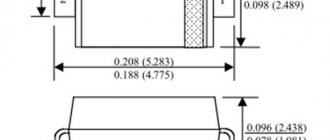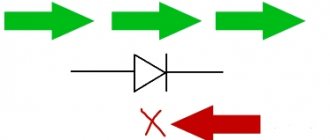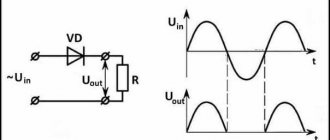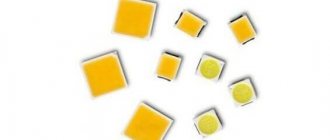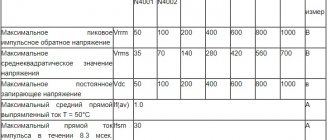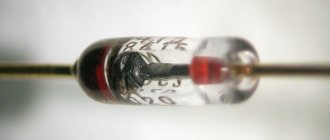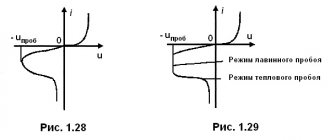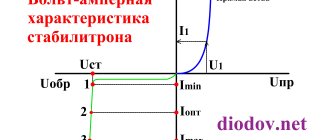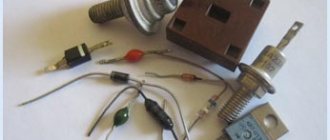Among electronic components, there are products that have firmly occupied certain market niches for many decades. They succeeded in this due to a successful combination of cost, technical parameters, and weight and size indicators. Such devices include a series of silicon diodes 1N4001-1N4007. In their field they are unrivaled.
Description and application of 1N-4007
Externally, 1N-4007 is a small black cylinder. It consists of a polymer resin used in the manufacture of most such elements. A semiconductor crystal is hidden inside. Its basis is monocrystalline silicon, obtained from sand through extremely high-tech technical processes.
There are two electrical terminals on the sides of the diode. Their task is to conduct current from the crystal to the board into which this part is soldered. The leads are made of copper and covered with a thin layer of solder, i.e. they're cheating.
Additional Information. Diodes are designed to pass electric current in one direction, i.e. from anode (+) to cathode (-). Their hydraulic analogue is a valve. This property is inherent in this part at the level of the silicon crystal lattice from which it is produced. There are also diodes based on germanium, but at the moment they are practically not used.
Appearance
1n4007, as well as all elements of this line, have a molded body made of non-flammable plastic. In order not to think about which side of this element is which, there is a colored stripe on the casing side of the cathode output.
Installation of such diodes is allowed both vertical and horizontal - it doesn’t matter. In general, these elements are very unpretentious, which, combined with their endurance and low cost, of course, makes them truly irreplaceable.
In appearance, they are no different from other diodes, and therefore it is necessary to pay attention to what markings are applied to the body.
It is very important that such diodes are very difficult to overheat when soldering, since it has long contact legs (about 2.5 cm), which, as is known, work as a heatsink. The 1n4007 diode itself can withstand direct heating up to 250 degrees for 10 seconds.
To summarize, we can say with confidence that the diodes of this line, as well as their analogues, are a very convenient solution when assembling circuits for various power devices for both 220 and 380 volts.
The 1N4007 diode is probably the most popular of all diodes, as it is installed in the vast majority of phone chargers, smartphones and tablets. Even if you are holding a charger for a dollar and there is no stabilization or interference filters inside, it cannot do without a diode.
And in one adapter there are four such diodes and a diode bridge is assembled on them; it is used to obtain direct voltage from alternating voltage. The diode allows current to pass through itself in only one direction, cutting off one of the voltage polarities.
Read also: Smokehouse for an electric stove
By the way, especially cheap chargers use half-wave rectification and save three out of 4 diodes. But if the power of the power supply is more than one Watt, then it is still better to use a diode bridge, since unipolar rectification produces much larger ripples, and this mode is much more difficult for filter capacitors.
The colored ring on the 1N4007 body indicates the cathode terminal.
Since the 1N4007 is produced with leads of sufficient length, the diode can be installed both vertically and horizontally.
The 1N4007 diode is one of the representatives of a whole series of diodes 1N4001, 1N4002, 1N4003, 1N4004, 1N4005, 1N4006, 1N4007. These types of diodes differ in the value of the maximum permissible reverse voltage (the values for each type are given in the table). 1N4007 is designed for the highest voltage.
| 1N4001 | 1N4002 | 1N4003 | 1N4004 | 1N4005 | 1N4006 | 1N4007 | |
| maximum permissible reverse voltage, V | 50 | 100 | 200 | 400 | 600 | 800 | 1000 |
| maximum AC voltage (rms value), V | 35 | 70 | 140 | 280 | 420 | 560 | 700 |
Since the cost of diodes from the entire 1N4001-1N4007 series is very low, and there is practically no difference in cost between types, there is no particular point in using different types in development and increasing the range. You can install 1N4007 everywhere, even if during repairs you need to replace a diode from this series with a lower voltage.
Installation 1N-4007
Diode 1n5819: characteristics
The part is installed on the board in the same way as any other two-terminal elements. The algorithm of actions is as follows:
- Using special needles and a soldering iron, the mounting holes for the part are cleaned of old solder. It is even more convenient to use tin oil.
- The diode leads are inserted into the holes according to polarity. It is indicated both on the board and on the part itself.
- The diode is pressed closely to the board. On the other side, the leads are bent. This is necessary to secure the part before soldering.
- The leads are soldered to the contact pads. Excess sections are shortened to the minimum length.
Specifications
The technical parameters of 1n4007 allow us to speak of it as a specialized rectifier diode designed for high alternating voltage networks with an operating frequency of up to 60 Hz. The maximum permissible operating values for the device are given in the datasheet taking this feature into account.
Limit parameters
Let's consider the main maximum permissible characteristics for 1n4007:
- peak reverse pulse voltage (VRRM) - up to 1000 V;
- maximum forward rectified current (IO) - up to 1 A;
- operating temperature range (TJ) from - 65 to + 175°C.
It is worth considering that the current in the capacitive load circuit should be 20% lower than for inductive and resistive loads. This is one of the properties of the device in question, which determines its operating mode.
Electrical parameters
The 1n4007 diode is characterized by high overload capacity and low junction voltage drop (VF) - up to 1.1 V (with IO up to 1A). Thus, the maximum instantaneous pulse current (IFSM), with a duration of 8.3 seconds, can reach 30 A.
Typical junction capacitance (CT) does not exceed 15 pF. Its value is determined at a frequency of 1 MHz and a constant voltage of 4 V. In theory, such an operating speed is unacceptable for rectifier diodes, therefore their use in high-frequency circuits is not regulated.
The leakage current does not exceed 5 µA. But with an increase in ambient temperature (TA), especially at more than +75 °C, it can increase to 50 μA. At the same time, all the indicators declared by the manufacturers are deteriorating. Therefore, to achieve efficient operation, it is necessary to maintain the standard 30% margin in parameters. It is also desirable to organize cooling, for example, using a special non-conducting thermal compound.
Technical characteristics of 1N-4007
It is best to look for the parameters of any part in its datasheet. Despite the low cost, the operating properties of the element are very decent. The main characteristics of the In 4007 diode include the following:
- peak reverse periodic voltage – 1000 V;
- maximum rms voltage – 700 V;
- permissible current in the forward direction – 1 A;
- peak forward current (one pulse 8.3 ms) – up to 30 A.
Diode 1n4007 characteristics Semiconductor diode
From the datasheet it is clear that all diodes in this line have the same current, but different voltages. For example, the 1N4001 diode has the following characteristics: 35 V / 1 A.
Important! When selecting a diode (and also a capacitor), you should take into account not the effective voltage, but the peak voltage. A voltmeter connected to the outlet shows 220 V. This is the current value. Peak – approximately equal to 310 V. Upeak = 1.41*Uday = 1.41*220 = 310.2.
Analogs 1N4007
Of course, such a popular diode could not be ignored by global manufacturers of semiconductor devices and released their complete analogues:
- Motorola - HEPR0056RT;
- Philips - BYW43;
- Diotec Semiconductor - 10D4, 1N2070, 1N3549;
- Thomson - BY156, BYW27-1000;
- domestic analogue - KD258D.
Post navigation
Diode 1N4007 characteristics:
- solder
For the 1N4001 - 1N4007 series, specifications are in the datasheet.
Sergey Yurievich
Does anyone know the limiting operating frequency of 1N40001? I am interested in the operation of these diodes in ULF (for example, in Shushurin’s ULF in place of D223B).
admin
Post authorI doubt that the 1N4001 is suitable for operation at audio frequencies. It is designed for 50 Hz (60 Hz). There is another, also widely used diode: 1N4148. This one might be suitable, it also has a domestic analogue KD522B.
- Root
In cases where the operating frequency of the diodes is not explicitly specified, look at the junction capacitance and the diode turn-off time. If the capacitance is more than 5 picofarads, and the turn-off time is more than 100 nanoseconds, then it has nothing to do in pulse, high-frequency and audio circuits, except perhaps as a rectifier or reference voltage source. If the capacitance and time are not indicated in the datasheet, then these parameters are not regulated at all and the diode should not be used in ULF signal circuits. This also applies to D223. In its place it would be better to put KD522 or 1N4148. Their speed characteristics are orders of magnitude better than those of the D223 and 1N4007, and in terms of maximum currents and voltages they are quite suitable for use in the circuit of the mentioned amplifier. Moreover, finding them is not a problem anywhere; diodes are very common.
Greg
A couple of additions: - the most common, after all, is 1N4004, since it is designed to operate on a 220V power supply, and manufacturers of chargers and other inexpensive equipment count every cent;
— the maximum current is indicated for constant voltage, and in the bridge two arms work alternately, so they can withstand 2-3 times more; — compound is different from compound, epoxy resin (the most common) will only worsen heat transfer, it’s better to leave it in the air, or fill it with a special non-conductive thermal compound. Root
I readily believe that in a bridge connection the diodes can withstand a current 2 times greater than that indicated in the datasheet.
But 3 times? How? However, you should not blindly trust imported datasheets for rectifier diodes in the place where the maximum values of forward currents are indicated. As a rule, an attempt to force a 1N40xx series diode to operate within the parameters specified in the documentation leads to its failure long before the deadline specified in the same documentation. The cases are too small and the cross-section of the leads is too small, and as a result, worse heat dissipation from the semiconductor. It is not for nothing that domestic rectifier CDs were made with leads of a much larger diameter at the same declared operating currents, and in larger packages. Greg
So currents, or rather their values, are different: peak, effective, etc. I indicated a simplified idea of the choice, nothing more.
The load is such and such, yeah - these are suitable, so as not to count. But it may have sounded like a call to use it in marginal operating conditions, but I did not call for this. Correction: use semiconductor devices with a 30% margin in all respects! About datasheets: you can and should trust those that are supplied in the box along with the parts. And then there are many analogues that are not quite similar. I won’t say anything about our CDs, I don’t want to talk about sad things. Innokenty
I have 20% of the reverse voltage reserve left in my memory for the domestic element base.
It is surprising that for foreign semiconductors there is no need to remember such a reserve, and the repeatability of their characteristics is many times better than in products of the domestic semiconductor industry. Greg
There - everything is better, definitely many times better, and sometimes even an order of magnitude better. No offense to the domestic industry, but at the border of the 80s and 90s it fell behind forever, and not for some years. Even then, it was necessary to purchase machines abroad, although this was hushed up for patriotic reasons, because ours not only could not cope with the increasing tasks of automation, but also could not get closer to them. And the decaying West... I had the opportunity to service such lines and visit where they were produced, so I know what I’m talking about.
Igor
Cheap power supplies also include full-wave rectifiers. In this case, the Chinese save two rather than three diodes.
Pinout 1N-4007
What is a diode - operating principle and device.
It is also the pinout. Indicates pin locations. Any diode has two of them. They are called anode and cathode. Roughly speaking, they can be called plus and minus, respectively. There is a ring strip on the body of this electronic component. It is located on the side of the cathode terminal.
There are two types of diode designations on the board. They also contain stripes. Their task is to show how to correctly install the element. The correspondence between the stripes on the real part and on the board is easy to remember from the picture below.
Diode strip
Diode Dimensions
The dimensions of the parts are especially important for designers and repairmen, because each element has its own standardized footprint on the board. 1N-4007 is available in DO-41 package. Its dimensions can be found in the datasheet for this part. At the same time, the manufacturer does not know in advance in which country its products will be sold. Therefore, dimensions are written in both inches and millimeters (mm in parentheses). Some sizes are represented by two numbers written as a fraction. They indicate the upper and lower tolerance limits.
Diode Dimensions
Diode marking
The body alone is not enough to identify the part. Therefore, it is customary to use short labeling. In the case of diodes from the 1 N 400X line, the designations on the case indicate the following:
- series name from 1N-001 to the most powerful of the line 1N-4007;
- electronic component manufacturer code;
- date of release of the part indicating the month and year.
Letters on a diode
The diode in question is also available in a surface mount package (SMD). Such parts are even smaller in size, so their markings are simplified to two characters.
Correspondence between conventional and SMD diodes
DIODES, ANALOGS
Here is the largest table of interchangeability of imported and domestic diodes collected on the Internet. Part 2. Complete and functional analogues of diodes. The datasheet for each diode can be viewed by entering its name in the datasheet search form on the right side of the site. Prices for radio components can be found in any online store.
At the bottom of the article you can download a guide to various diodes or view it online.
Imported. Domestic.
1N3064 KD521A 1N3064M KD521A 1N3065 KD521A 1N3067 KD521G 1N3082 KD205G 1N3083 KD205B 1N3121 D220 1N3184 KD205A 1N3193 KD205L 1N3194 D 229L 1N3228 KD105G 1N3229 KD205A 1N3238 D229Zh 1N3239 KD205L 1N3253 KD205L 1N3254 D229L 1N3270 D246B 1N3277 KD205L 1N3278 D229L 1N3282 M D218 1N3545 KD205G 1N3547 D229L 1N3600 KD209A 1N3604 KD521A 1N3606 KD521A 1N3607 KD521A 1M3639 KD205L 1N3640 D229L 1N3657 D246B 1N3659 KD205L 1N3748 KD205G 1N3749 KD205B 1N3750 KD205ZH 1N3827 KS456A 1N3827A KS456A 1N3873 KD509A 1N3873H KD509A 1N3954 KD509A 1N4001 KD208, KD209, KD226A, KD243A 1N4002 KD243B 1N4003 KD243V 1N4004 KD243G 1N4005 KD 243D 1N4006 KD243E 1N4007 KD243Zh 1N4008 MD3B 1N4099 KS168A 1N4147 KD503A 1N4148 KD510, KD521A, KD522B, KD106A 1N4149 KD521A 1N4150 KD522B, KD106A 1N4153 KD521A 1N4305 KD521A 1N4364 D229Zh 1N4365 KD205L 1N4366 D229K 1N4367 D229L 1N4437 D246 1N4438 KD206V 1M4439 KD210B 1N4446 KD521A, KD522B 1N4447 KD521A 1N4448 KD521A 1N4449 KD521 A 1N4454 KD521A 1N4531 KD521A 1N4622 KS139A 1N4624 KS147A 1N4655 KS456A 1N4686 KS139A 1N4688 KS147A 1N4734 KS456A 1N4817 KD208A 1N5151 KD521A 1N5209 D223B 1N5216 KD205B 1N5217 K D205Zh 1N5318 KD521A 1N5392 KD208A 1N5393 KD258A 1N5395 KD258B 1N5397 KD258V 1N5398 KD258G 1N5399 KD258D 1N5400 KD280A 1N5401 KD227A, KD 280B 1N5402 KD280V 1N5404 KD280G 1N5406 KD280D 1N5407 KD280E 1N5408 KD280Zh 1N5624 KD257A 1N5720 KD503A 1N5819 KDSh2105V 1P644 D229V 1P647 D229E 1S032 KD205L 1S034 D229L 1S41 KD205L 1S43 D229L 1S101 KD205L 1S10 3 D229L 1S113 D229E 1S148 D229K 1S162 D243 1S163 D245 1S164 D246 1S165 KD206B 1S307 D18 1S313 KD205V 1S314 KD205B 1S315 KD205A 1S421 D243 1S423 D246 1S427 KD210B 1S473 D811 1S544 KD210B 1S558 KD205A 1S559 KD205B 1S1219 KD521G 1S1220 KD521G 1S1230 KD205B 1S1231 KD205A 1S1232 KD205ZH 1S1473 KD521G 1S1763 KD2 05B 1S1943 KD205B 1S1944 KD205ZH 1T502 KD205G 1T504 KD205B 1T505 KD205A 1T506 KD205ZH 20S5 KD205G 20TQ045 KDSH2965B 20TQ060 KDSH2965A 24J2 D223B 2A04 KD411EM 2A05 KD411VM-DM 2A06 KD411AM, BM , NM 2T502 KD205G 2T504 KD205B 2T505 KD205A 2T506 KD205Zh 3C15 D303 3T502 KD205G 4T502 KD205G 7.00E+01 D229ZH 7J1 D229ZH 7J2 KD205L 75R2B KD205L BAS32 KD811A BAV682 KD811B BY296P KD266A BY297P KD226B BY298P KD226V BY299P KD226D DL4148 KD521A, 522B-SMD ESP5300 D245B F0100 KD509A F1E3 D245B F1K3 D248B F2B3 L242 F2H3 KD206B F2M3 KD203G F2N3 KD210B FD600 KD521A FDN600 KD521A FPZ5V6 KS456A FR101 KD247E FR102 KD247A FR103 KD247B FR104 KD247V FR105 KD247G FR106 KD247D FR153 KD258A FR154 KD258B FR155 KD258V FR156 KD258G FR157 KD258D FR202 KD226A FR203 KD226B FR204 KD226V FR205 KD226G FR206 KD226D FR303 KD257A FR304 KD257B FR305 KD257B FR306 KD257G FR307 KD257D G65HZ D248B G1010 D242 G3010 D245 G4010 D246 GP15d KD258A GP15g KD258B GP15j KD258 V GP15k KD258G GP15m KD258D HDS901 KD521G HDS9003 KD509A HMG626A D220 HMG662 D220B HMG662A D220B HMG663 D220B HMG844 D220B HMG904 KD521G HMG904A KD521G HMG907 KD521G HMG907A KD521G HMG2873 KD509A HMG3064 KD521A HMG3596 KD521G HMG3598 KD521A HMG3600 KD509A HMG4150 KD509A HMG4319 KD521A HMG4322 KD509A HR9 D818A HS033A KS133A HS033B KS1 33A HS2039 KS139A HS7033 KS133A HS9010 KD521G HS9501 KD521A HS9504 KD521A HS9507 KD521A JE2 KD205L LAC2002 KS147A LD57C AL336V LDD5 KD521B LDD10 KD521 B LDD15 KD521B LDD50 KD521B LR33H KS133A M1B1 KD208A M1B5 KD208A M1B9 KD208A M4HZ D229E M14 D229V M68 D229Zh M69B KD205L M69C KD205G M500B KD205E M500C KD205A R604 D246 R606 KD206V R612 D243 R 614 D246 R616 KD206V RGP10a KD247E RGP10b KD247A RGP10d KD247B RGP10g KD247V RGP10j KD247G RGP10k KD247D RGP15d KD258A RGP15g KD258B RGP15j KD258V RHP15k KD25 8G RGP15m KD258D RGP30d KD257A RGP30g KD257B RGP20j KD257V RGP30k KD257G RGP30m KD257D RL204 KD411EM RL205 KD411VM-DM RL206 KD411AM, BM, NM RZ18 KS218ZH RZ22 KS222ZH RZZ11 KS211ZH S1.5-0.1 KD208A S2A-12 D243 S2E20 KD205G S2E60 KD205ZH S5A1 D304 S5A2 D243B S5A3 D245B S5A6 D248B S5AN12 KD206B S6AN12 KD206B S7AN12 KD203G S8AN12 KD210B S15 KD205A S17 KD205G S18 KD205A S18A KD205A S19 D7Zh S20-06 D248B S23A KD20 5Zh S26 D229K S28 KD105G S30 KD205Zh S31 KD205V S83 D229K S92A KD205L S101 KD205G S106 D7Zh S205 D210 S206 D211 S208 MD217 S210 MD218 S219 D7Zh S222 KD205G S223 KD205V S234 KD105G S252 KD205G S253 KD205V S256 KD105Zh S425 KD206V S427 KD210B S65250 KD509A SD1A KD205Zh SD11 D101 SD17Z KD205G SD91A D229Zh SD92A KD205L SD93 D229K SE05B KD205Zh SE05S KD205G SE1.5SS KD208A SFD43 KD521G SFD83 KD521G SG203E, K D243B SG5200 KD521A SG5260 KD521A SJ103E, K D304 SJ104E, K D242 SJ204E, K D243 SL3 D245B SM20 KD205L SM230 D229K SV131 D818A SV134 D811 SVM91 D818A SVM905 D81 8A SVM9010 D818A SVM9011 D818A SVM9020 D818A SVM9021 D818A SW05B KD205ZH SW05S KD205G SW1S D229ZH SW1SS KD205L SZ9 D818A SZ11 D811 TIC106 KU223I TF24 D226V TK20 KD205L TK40 D229L TMD45 D207 TS1 D229ZH TS2 KD205L TS4 D229L UR215 D303 UP12069 KD205L UP12070 D229L UP12070A D229L URE100 X D304 URF100X D304 URG100X D304 UT112 D229Zh UT113 KD205L UT114 D229K UT115 D229L UT212 D229K UT213 D229L XS10 D229Zh XS17 KD205L Z1550 KS156A Z1555 KS15 6A Z1560 KS156A Z1565 KS156A Z1570 KS156A Z1A5.6 KS156A Z1A6.8 KS168A Z1A11 D811 Z1B5.6 KS156A Z1B6.8 KS168A Z1B11 D811 Z1C5.6 KS156A Z1C11 D811 Z1D6 ,8 KS168A
- SMD PARTS CASE: PHOTOS AND DIMENSIONS
Replacing component 4007
It is better to replace any parts with the same ones. If you don’t have the necessary diodes at hand, you can look for them in phone chargers, various power supplies, energy-saving and LED light bulbs, children’s toys or control units for New Year’s garlands. Analogues of the 1N4007 diode are selected taking into account the characteristics.
Domestic analogues
One of the most suitable replacement options is the Russian component KD258D. It has the same reverse voltage of 1000 V as the 4007. At the same time, its forward current is 3 A, which is three times higher than the component it is replacing. Attention should be paid to the temperature. 1N-4007 is capable of operating at 150 C, and KD258D can withstand only 85.
Foreign analogues 1N-4007
Imported manufacturers boast a wider list of parts suitable for replacing a faulty diode. For example, 1N-1236 has similar characteristics. Its maximum voltage is slightly inferior to 4007 and is 800 V, and the forward current exceeds 1.6 A. 1N-1925 will be much more powerful - 800 V / 4 A. If the operating voltage is fundamental, then 1N-2193 - 1000 V / 3 A will do.
Analogs
Domestic analogues presented in the table are considered for 1N4007:
| Replacement | VR | VF | IF |
| 1N4007 | 1000 | 1 | 1 |
| KD528D | 1000 | 1,5 | |
| KD243Zh | 1000 | 1,1 | 1,5 |
Note: the data in the table for the 1N4007 diode and those suitable for replacement are taken from the manufacturer's datasheet.
Imported manufacturers offer larger rectifier diodes to replace the 1N400X. The most suitable technical parameters are:
- HEPR0056RT (Motorola),
- BYW27-1000 / BY156 (SGS Thomson Microelectronics),
- BYW43 (Siemens AG),
- 10D4 / 1N2070 / 1N3549 (several US manufacturers).
Advantages
4007 are famous for their prevalence and versatility. Because of this, people are very familiar with these elements and often prefer them in their homemade projects and for repairs.
However, the main advantage is the price. At the end of 2022 they cost only 4 cents/piece. In a well-known Chinese online store it’s even less – 58 cents/100 pieces. Despite this price, the diodes in question have decent parameters of 1000 V / 1 A, which is beyond the capabilities of many competitors who are tens of times more expensive.
Switching speed of 1N4000 and 1N5400 diodes
As mentioned above, the switching speed of all these diodes is relatively slow due to the internal capacitance of the semiconductor (between 10pF and 15pF), so they are not suitable for high frequency operation.
Their best application is to use them as network rectifiers (50Hz/60Hz) or to work with frequencies of no more than 1000 Hz.
And as suppressors in inductive loads, it is better to have the diode as fast as possible to suppress the self-induced emf, which creates interference and can damage the power transistors that drive the inductive load. In these cases, it is better to use fast Schottky-type diodes.
Transistor tester / ESR meter / generator
Multifunctional device for testing transistors, diodes, thyristors...
More details
In any case, with small motors or relays, diodes such as 1N4006 or 1N4007 work correctly and are a practical and economical solution.
How to check 1N-4007
The easiest way to check this component is with a multimeter in diode testing mode. On the slide switch (drum) it is indicated by the symbol of this electronic component. The test is performed in 2 stages. In one case, the red probe of the device is connected to the anode, and the black probe to the cathode of the diode. The multimeter should show a voltage drop of 600-700 mV. In the second case, the polarity of the connection changes, i.e. red - to the cathode, black - to the anode. The device will show “1”. This means that the diode does not conduct current in this direction. If both of these conditions are met, then the part is considered serviceable.
Note! There is such a thing as a floating fault. With this problem, the part may or may not work for no known reason. Those. During the test, the diode will appear to be working, but in reality it will be burnt out. Fortunately, such malfunctions are extremely rare.
Characteristic
When a diode from this series is in conduction, there will be a voltage (drop voltage) at its terminals, which can vary from 0.7 to 1.2 V, depending on the amount of current passing through it.
If a significant current flows through the diode, the diode body will heat up due to power dissipation, which can reach up to 1 W (P = V * I).
Be that as it may, these diodes are quite reliable and can operate at high temperatures.
Features of application
Model 1N-4007 refers to rectifier devices. The maximum operating voltage of 1 kV makes it easy to use it in a 220 volt household network. These two factors determine its use. The 4007 is used as part of input diode bridges for devices with power below a couple of hundred watts. As a rule, these are cheap light bulbs, chargers and other small electronics.
Elements from the 1N400X line have proven themselves to be a reliable radio amateur companion. Even professionals do not disdain them. This is explained by their price and prevalence in modern technology, as well as impressive electrical characteristics.
1N4000 Series 1 Amp
The 1N4000 series diodes allow a maximum current of 1A and are commonly used as rectifiers in power supplies and AC adapters. They can also be used as suppressors in inductive loads such as relays or motors, but since they are relatively slow they are not well suited for this purpose.
